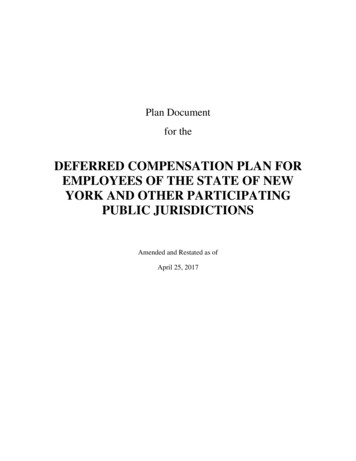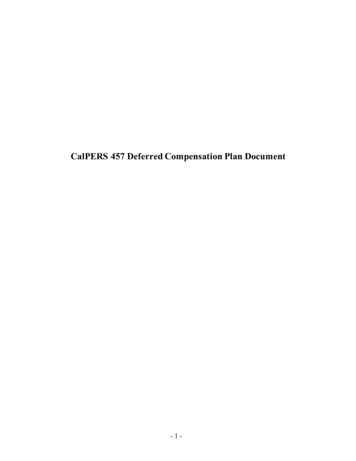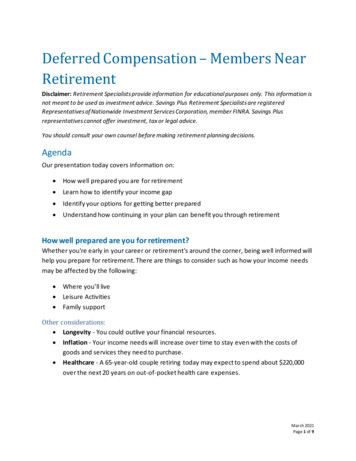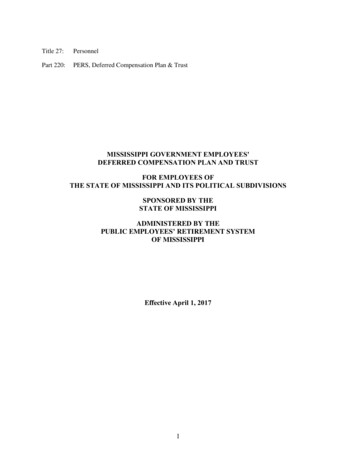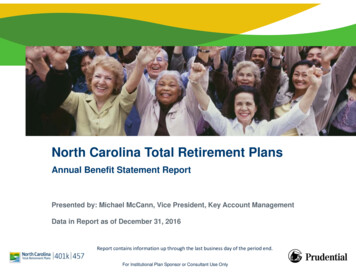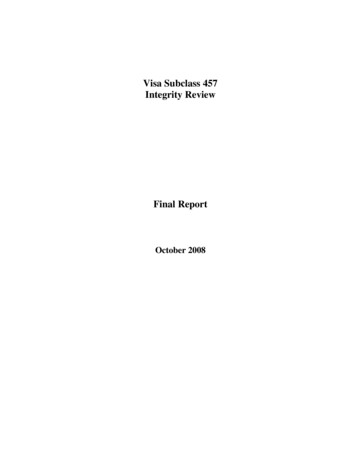
Transcription
457(b) Deferred CompensationOverview for Governmental and Public School entities
Retirement experts agree.having the money you wantin your later years requirescareful planning now.Plan ahead.
To help you pursue your financial goals, your employeris sponsoring a 457(b) deferred compensation program.How does the 457(b) deferredcompensation plan work?With a 457(b) deferred compensationplan, you postpone receiving (defer) aportion of your salary. It works like this: You decide, within certain InternalRevenue Code (IRC) limits, how muchof your income you want to defer. Your employer will reduce yourpaycheck before withholding federaland, if applicable, state income tax bythat amount and forward it to Voya on a regular basis. You decide how your contributionsare invested, utilizing one or moreinvestment options available inthe plan. The contributions and any earningsthat accumulate over the years arenot taxed until you receive them.(Money distributed from the plan willbe taxed as ordinary income in theyear the money is distributed). That’susually at retirement when you maybe in a lower tax bracket. Your employer’s 457(b) deferredcompensation plan has no effecton the benefits you will receivefrom Social Security. Your SocialSecurity contributions and benefits(if applicable) will be based on yourtotal pay, including the amounts paidinto the deferred compensation plan.Deferred compensation plans areauthorized under Section 457 of theInternal Revenue Code. This sectionpermits the tax-favored treatment ofcontributions for eligible employees ofeligible governmental and tax-exemptemployers. In order to maintain thistax-favored treatment, legislationrequires that plans maintained bygovernment employers hold all assetsand income in trust, in custodialaccounts, or in annuity contracts forthe exclusive benefit of participantsand beneficiaries.Your employer’s 457(b)deferred compensation planoffers important benefits.Tax-deferred contributionsand accumulationBy deferring compensation, youhave the opportunity to: Lower your current federal and,if applicable, state income taxesbecause you postpone paying taxeson contributions and investmentearnings until you withdraw themat retirement – a time when youmay be in a lower tax bracket; Enjoy the opportunity for tax-deferredcompounding of your assets (seeexamples on the next page); and Potentially accumulate morefor retirement than you would withan after-tax retirement savings plan,because more of your money has theopportunity to work for you.
The power of long-term savingsTo illustrate how contributing towardretirement on a pre-tax basis affectsyour paycheck, let’s assume you earn 30,000 in taxable income annuallyand you want to defer 75 fromeach paycheck to a deferredcompensation plan. You’re paid everyother week – 26 times a year.Now, compare how the 75 biweekly contributions could accumulate overtime when federal income taxes are assumed to be assessed at 25%, and theinvestments earn an assumed 6.0% annual rate of return. By contributing on atax-deferred basis and leaving earnings to compound over a long period of time,more value could accrue with deferred compensation than if taxes were paidevery year with an after-tax savings plan.BeforejoiningplanAfterjoiningplanAfter-Tax Savings PlanDeferred Compensation PlanBiweekly contribution 75.00 75.00Less income tax (25%)– 18.75– 0.00Income afteradjustments56.2575.00 1,154.00 1,154.00Net yearly contribution457(b)contribution-0.00-75.00Net taxableincome1,154.001,079.00Federal incometax (25%)-288.50-269.75Take-home pay 865.50 809.25Net biweekly contribution 1,462.50 1,950.00After 10 YearsTotal contributionInvestment earnings at 6.0%Less income tax on earnings (25%)Total 14,625 5,017– 1,254 18,388 19,500 6,996–0 26,496After 20 YearsTotal contributionInvestment earnings at 6.0%Less income tax on earnings (25%)Total 29,250 23,590– 5,898 46,942 39,000 34,946–0 73,946After 30 YearsTotal contribution 43,875Investment earnings at 6.0% 63,217Less income tax on earnings (25%)– 15,804Total 91,288After-tax value followinga lump-sum distribution 91,288With deferred compensation, yourcurrent federal income tax is reduced,so it only costs you 56.25 out-ofpocket to invest 75.00. 58,500 100,421–0 158,921 119,191This chart does not reflect any record keeping, administrative or contract fees. Had they been reflected, the return of thevariable annuity would be lower. Lower maximum tax rates on capital gains and dividends would make the investment returnfor the taxable investment more favorable, thereby reducing the difference in the performance between the accounts postedabove. Consider your personal investment horizon; current and anticipated income bracket when making an investmentdecision as those may further impact the results of this illustration. Bear in mind that changes in tax rates and tax treatmentof investment earnings may impact the comparative results. Income tax is due upon withdrawal of deferred compensationamounts. The returns are hypothetical, are not guaranteed and do not reflect the performance of any specific investment.Systematic investing does not assure a profit and does not protect against loss in declining markets. Investors shouldconsider their financial ability to continue their purchases through periods of low price levels. 180(in thousands of dollars) 160 140n After-Tax Savingsn Deferred Compensation Plan (Pre-Tax)n D eferred Compensation Plan (After-Tax) 158,921 120 100 119,191 80 91,288 60 73,946 40 0 55,459 46,942 20 18,388 26,49610 YEARS 19,87220 YEARS30 YEARS4
Your biweekly contribution amount isimportant to your retirementaccumulations over time. Comparethese notable results when weincrease the deferred compensationbiweekly contribution by 5 and keepall previous assumptions, including the6.0% annual rate of return, the same.457(b) Accumulation amountAccumulationYears1 year10 years20 years30 years 75AccumulatedValue 2,01026,49673,946158,921 80AccumulatedValue 2,14428,26278,875169,516This illustration is hypothetical, is not guaranteed, and is notintended to reflect the performance of any specific investment.There is no assurance that increasing contributions willgenerate investment success. In addition, these figures do notreflect taxes or any fees or charges that may by assessed bythe investments. The tax-deferred investment will be subject totaxes upon withdrawal. Systematic investing does not ensurea profit nor guarantee against loss. Investors should considertheir financial ability to continue investing consistently in up aswell as down markets.Meaningful contribution limitA yearly amount set by the IRS*(thereafter adjusted annually), or 100%of includible compensation, whicheveris less. (Includible compensation isthe amount of compensation of theparticipant from the employer forthe year, and includes deferrals tothe employer’s 457(b), 403(b), 401(k),SARSEP, SIMPLE, and 125 Cafeteriaplans. As with 403(b), 457(b) includiblecompensation does not include 414(h)pick-ups.) When you attain age 50,or near your plan’s normal retirementage, you may be able to defer more ofyour income under one of the specialcatch-up provisions.Your plan allows you to change theamount of compensation you deferas your retirement planning needschange. You may: Increase the amount you deferup to the IRC maximum; and Reduce, stop, or restartdeferrals according to the plan’sadministrative procedures.Designated Roth contributionsYour employer may choose to permitemployees to irrevocably designatesome or all of his or her participantcontributions under the plan asdesignated Roth contributions. Unlikepre-tax elective deferral contributions,designated Roth contributions arecurrently includible in gross income.Designated Roth contributions aretreated the same as pre-tax electivecontributions for most purposes,including the annual contributionslimits. In addition, a 457(b) plan that hasa Roth account feature may permit aparticipant or spousal beneficiary whohas a distributable event to directlyroll over eligible amounts to the plan'sRoth account. A qualified distributionof designated Roth contributions isexcludable from gross income. Thefollowing criteria must be met to ensurea tax-free qualified distribution: 5-yearholding period and the participant hasexperienced one of these events: Attainment of age 59½ (assuming youhave separated from service) Disability DeathProfessionally managedinvestment optionsPlan assets are held for you inan account and your employeris responsible for making futurepayments to you. You can selectthe investment options to suit yourindividual needs or objectives. Youmay be able to: Customize your own portfolio tomatch your individual needs; Diversify or spread your contributionsover different options, therebypotentially reducing investment risk**;and Change the mix of your currentcontributions and transfer pastdeposits among the various options.* Please refer to www.voya.com/IRSlimits for currentlimitations.** While using diversification as part of your investmentstrategy neither assures nor guarantees betterperformance and cannot protect against loss indeclining markets, it is a well-recognized riskmanagement strategy.
PortabilityPlease Note: This feature is notavailable to all plans. Please see yourplan documents to determine if yourplan contains this provision.A 457(b) deferred compensation plansponsored by a governmental entity(which would include a public school)is “portable.” This means that if yougo to work for another employer, youmay be able to roll over your accountbalance to your new employer’seligible retirement plan, such asa governmental 457(b), 403(b), or401(a)/(k), if the plan permits. Accountassets may also be rolled over into atraditional or Roth IRA. You may also,if the plan permits, leave your assetsin your former employer’s plan. Ifyou do so, your assets will continueto accumulate tax-deferred until theIRC requires that you begin receivingRequired Minimum Distributions (RMDs)triggered when you attain age 701 2 orretire, whichever comes later.A governmental 457(b) plan mayalso include provisions allowing foradditional access to your accountbalance. Your account balance maybe withdrawn by an alternate payeeunder a qualified domestic relationsorder, once your account is dividedin accordance with the court order.You may also be able to transferthe account balance from yourgovernmental 457(b) plan directlyto a governmental defined benefitplan, for the purchase of service creditunder that defined benefit plan. Agovernmental 457(b) plan may allow aparticipant to receive a loan from theplan assets. While taking a loan fromyour retirement plan may not be thebest option, it is something for you toconsider. A governmental 457(b) planmay also include a provision allowingthe in-service distribution of accountsthat do not exceed 5,000, if certainconditions are met. In addition, a 457(b)plan must also provide that the accountbalance be distributed to satisfy RMDs.Plan assets rolled from another plantype into a governmental 457(b)deferred compensation plan would stillremain subject to an IRS 10% prematuredistribution penalty tax if distributedprior to age 591 2, unless anotherexemption applies. Furthermore, anyamounts rolled from a governmental457(b) deferred compensation planto another plan type (e.g., 401(a)/(k),403(b), traditional IRA, etc.) would thenbecome subject to the same IRC 10%premature distribution penalty tax if,again, distributed prior to age 591 2unless another exemption applies.Access to your money fora financial emergencyIf you choose to take your accountbalance, the distribution will be taxablein the year you receive the money.However, if your account balance ispaid out in a series of payments over aperiod of time, you will only pay federalincome taxes on the amount receivedeach year. l oss of your property due tocasualty; or other similar extraordinaryand unforeseeable circumstancesarising as a result of events beyondyour control.Generally, withdrawals from a 457(b)plan are not allowed unless you retire,attain age 701 2, sever employment,or die. However, a withdrawal cangenerally be made to meet an“unforeseeable emergency” asdefined by the IRC, if your employer’s457(b) plan allows. An unforeseeableemergency means a severe financialhardship to you resulting from: a n illness or accident of you or yourspouse or dependent;Note: if permitted by the 457(b)plan document, an unforeseeableemergency means a severe financialhardship of you resulting from an illnessor accident of your primary beneficiarydesignated by you under the 457(b)plan. In addition, a 457(b) plan maypermit a beneficiary of a deceasedparticipant or alternate payee to take anunforeseeable emergency distribution.In addition, if permitted under a457(b) plan document, you may beeligible to receive an unforeseeableemergency withdrawal, based on asevere financial hardship resulting froman accident or illness of a primarybeneficiary designated by you underthe 457(b) plan.The purchase of an automobile, or exceptunder extraordinary circumstances, thepurchase of a home and the paymentof college tuition are not consideredunforeseeable emergencies.Transferring benefits toanother 457(b) planAfter severance from employment withyour current employer sponsoring the457(b) plan, you may transfer your planassets to another governmental 457(b)plan, if both your current plan and theplan to which you would like your assetstransferred, permit such a transfer.Payment choicesYou can receive your benefits in anyone of the following ways, subjectto the terms of your employer’s plandocument. Remember, taxes are due atdistribution, so we suggest you discussyour federal and, if applicable, stateincome tax liability with your accountantor attorney before choosing an option: Distribution over your lifetime; Distribution over your lifetime andthe lifetime of your designatedbeneficiary; Distribution over a set time periodnot extending beyond your lifeexpectancy; Distribution over a set time period notextending beyond the joint and lastsurvivor life expectancy of both youand your designated beneficiary; Lump sum, or partial lump sumdistribution in combination with oneof the other options;
An estate conservation optionthat allows you to receive only theminimum amount required by lawat either age 70½ or retirement,whichever comes later; and A systematic withdrawal optionthat provides periodic income foreither a specific dollar amount or aspecified time period at retirement orseparation from service.Please note: Variable annuities and mutualfunds offered through a retirement plan areintended as long-term investments designed forretirement purposes. Early withdrawals from avariable annuity may be subject to a deferredsales charge. Money distributed from the planwill be taxed as ordinary income in the yearthe money is distributed. Investments are notguaranteed and are subject to investment riskincluding the possible loss of principal. Accountvalues fluctuate with market conditions, andwhen surrendered the principal may be worthmore or less than its original amount invested.An annuity does not provide any additional taxdeferral benefit, as tax deferral is provided bythe plan. Annuities may be subject to additionalfees and expenses to which other tax-qualifiedfunding vehicles may not be subject. However,an annuity does provide other features andbenefits, such as lifetime income payments anddeath benefits, which may be valuable to you.Death benefitsUpon your death, your designatedplan beneficiary will receive benefitsaccording to options/time framesoutlined in the plan. If you die beforebenefits commence and your planbeneficiary is also your spouse, he orshe is not required to begin receivingpayments any earlier than when youwould have reached age 701 2.If you die after benefits havecommenced, the balance of youraccount must be distributed at least asrapidly as under the method in effectat your death.Personalized, promptaccount serviceYour local representative, well-trainedand experienced in retirementeducation, is eager to help you: Understand retirement concepts; Formulate retirement goals withhypothetical computer illustrations;andAccount statements summarize yourinvestment account activity and reflectyour account balance. Your reportwill specify any changes in value and/or transfers you’ve made among theinvestment options. These reportsare mailed quarterly; however, forsome transactions (such as investmentchanges), a confirmation statement issent to you immediately. You can alsospeak with your representative to findout how to "go green" and receiveonline statements.Toll-Free telephone services areavailable seven days a week, 24 hoursa day, for account information andinvestment option changes.Newsletters include communicationsand updates from our technical andinvestment staffs.With Voya, you won’t get lost in thecrowd. You can count on your localrepresentative and our personalizedcustomer services to help you answerany questions you may have regardingyour account. Establish and periodically reviewyour investment objectives.In addition, our state-of-the-artcommunication program placesinformation and your account status atyour fingertips with these services:Internet access allows you tomake account inquiries and investmenttransfers, obtain fund unit values,and more. Our website offers aninformational, interactive guide to helpyou consider financial and investmentalternatives, while a state-of-the-artsecurity system ensures that you alonehave access to your account.It’s easy to get startedTo begin participating in the plan, complete the appropriate participation/enrollment materials.This booklet provides only an overview of deferred compensation. Please see your representativeon how deferred compensation can help you pursue your financial goals.
Not FDIC/NCUA/NCUSIF Insured I Not a Deposit of a Bank/Credit Union I May Lose Value I Not Bank/Credit Union Guaranteed I Not Insured by Any Federal Government AgencyYou should consider the investment objectives, risks, and charges and expenses of the variable product and its underlying fund options, ormutual funds offered through a retirement plan, carefully before investing. The prospectuses/prospectus summaries/ information bookletscontain this and other information, and can be obtained by contacting your local representative. Please read the information carefully beforeinvesting.Insurance products, annuities and retirement plan funding issued by (third party administrative services may also be provided by) Voya Retirement Insurance and Annuity Company (“VRIAC”),Windsor, CT or ReliaStar Life Insurance Company, (“ReliaStar”), Minneapolis, MN. VRIAC or ReliaStar is solely responsible for meeting its obligations. Plan administrative services provided byVRIAC or Voya Institutional Plan Services LLC (“VIPS”). VIPS does not engage in the sale or solicitation of securities. All companies are members of the Voya family of companies. Securitiesdistributed by Voya Financial Partners LLC (member SIPC) or third parties with which it has a selling agreement. Custodial account agreements or trust agreements are provided byVoya Institutional Trust Company. All products or services may not be available in all states. Only VRIAC is admitted and its products offered in the state of New York.146206 3011372.X.P-14 2018 Voya Services Company. All rights reserved.CN0928-45256-1020DVoya.com
eligible retirement plan, such as a governmental 457(b), 403(b), or 401(a)/(k), if the plan permits. Account assets may also be rolled over into a traditional or Roth IRA. You may also, if the plan permits, leave your assets in your former employer s plan. If you do so, your assets will continue to accumulate tax-deferred until the


